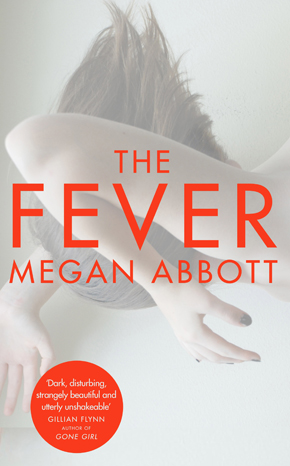The body speaks
by Megan AbbottThe girl on the TV screen is smiling, nervously. She’s talking about all the things she used to do: art class, cheerleading. “I was always so active,” she says. And then you see something’s wrong, her words halting, her head jerking. “Everyone was always so happy to be around me.” A pause, her eyes troubled. “I just don’t feel like myself anymore.”
She was one of eighteen female teens in the small town of Le Roy, New York who were afflicted with similar vocals tics and twitches. And for a few months in early 2012, they were everywhere: the morning shows, CNN, every major newspaper and magazine. Channel 4 even aired a documentary about the case: The Town That Caught Tourette’s. All these fresh-faced young women begging for answers to the baffling affliction that seemed to be spreading through their school like a plague. And that fear in their eyes, which was so complicated, so haunting and so vivid: What’s happening to me? Will it ever stop? When will I be myself again? And, perhaps, What if no one believes me?
Within days of first hearing about the young women of Le Roy, I began writing The Fever, which chronicles a mysterious outbreak in a small town. In the novel, we see everything through the eyes of the Nash family: Tom, a high-school teacher and divorced dad, and his two teenage children, Eli and Deenie. One by one, Deenie’s friends are struck by violent, unexplained seizures and fear and panic spreads through the town.
The Fever diverges greatly from the real-life case, but writing the book while watching the events in Le Roy unfold was a disarming process. Ultimately, the medical diagnosis – accepted by most – was that the Le Roy girls were suffering from ‘conversion disorder’, a condition in which the body ‘converts’ emotional distress into physical symptoms. In other words, the body speaks what one cannot express. Though psychological in origin, the symptoms are involuntary and completely real. When it occurs in groups, spreading from one to the next, it is called ‘mass psychogenic illness’, or ‘mass hysteria’.
Hysteria has taken many forms, but it has consistently been considered a ‘women’s disease’ and each era’s interpretation seem to reflect its own anxieties about women.”
The word hysteria is out of favour among mental-health professionals – both because it’s been used to describe so many different nervous conditions that it’s become meaningless and because it’s so culturally laden. And, over the centuries, has been used so frequently to diminish or even pathologise women. Dating back at least as far as 1900 BC, ‘hysteria’ was a nervous condition believed to be caused by the movement of the uterus from its normal place within the body (the word itself derives from hystera, the Latin word for womb). In Ancient Egypt, cures were proffered: perfumes could fumigate the woman’s body to draw the uterus back up into position, or potions could be taken orally to drive the uterus down. Plato even writes of the displaced uterus as caused by women’s lack of sexual activity. The cure was marriage and pregnancy
Over the centuries hysteria has taken many forms, but it has consistently been considered a ‘women’s disease’ and each era’s interpretation seem to reflect its own anxieties about women. In the Middle Ages, hysteria was blamed on witchcraft and demonic possession. In the 17th century it was thought to be a brain disorder that women ‘catch’ more easily because of their delicate constitutions. In the Victorian era, in many ways the heyday of hysteria and a time of particularly conservative gender ideals, the condition took on moral overtones, with many doctors blaming hysteria’s prevalence on troubling female behaviour of every variety.
It was not until the end of the 19th century and into the 20th, when Sigmund Freud intervened and offered a different interpretation, seeing hysteria as the result of emotional crisis. He believed ‘hysterics’ had suffered some kind of unresolved trauma or intense conflict that then took physical form: nervous tics, losing one’s voice, etc. And women were more likely to suffer because they suffered greater social repression. It was harder for them to voice their trauma in a society that told them their voice meant little.
In The Fever, the role trauma may play in the condition ‘seizing’ the girls – including Deenie’s close friends – emerges slowly. But in terms of the way the condition spreads, I was very compelled by theories suggesting why conversion disorder and mass psychogenic illness are in fact more common among women and girls. Sociologist Robert Bartholomew, an expert in mass psychogenic illness, told me that at least part of it has to do with “how females are socialised to internalise stress.”
But one of the lingering and harmful prejudices in terms of hysteria and females did seem to emerge during the Le Roy case and it affected me deeply. Many times, both in internet comments and in the occasional media piece, the afflicted girls themselves who were put on trial were accused of faking their symptoms, of being dramatic look-at-me teenage girls, of making it all up as if it were a game. Conversion disorder and mass psychogenic illness are real conditions. They’re not psychosomatic conditions and the girls’ motor disorders were not faked. The painful tics they experienced were very real – they just derived from psychological distress.
I can’t say all of this was conscious to me as I wrote The Fever. I don’t tend to write fiction from an analytical or intellectual position. Instead, I focus on story, on character. But I don’t know if I would have written this book without these issues fascinating and troubling me. In particular, the fact that – despite knowing more than ever about how the mind works, how the body works, and as confident as we feel that science can solve all these mysteries and there’s a pill for everything – sometimes something can still happen to remind us the world is still an enigmatic place, filled with tumult and ambiguity. We can still find ourselves back in the fog, struggling with life’s puzzles. And in those puzzles, there is fear and heartache and beauty – the stuff of life, bright and dark.
 Megan Abbott is an Edgar award-winning author of noir fiction including Queenpin and Bury Me Deep. Her novel The End of Everything was a 2011 Richard and Judy selection and Dare Me was shortlisted for the CWA Steel Dagger 2012 and will soon be a major motion picture. Born in Detroit, she now lives in Queens, New York. The Fever is published by Picador. Read more.
Megan Abbott is an Edgar award-winning author of noir fiction including Queenpin and Bury Me Deep. Her novel The End of Everything was a 2011 Richard and Judy selection and Dare Me was shortlisted for the CWA Steel Dagger 2012 and will soon be a major motion picture. Born in Detroit, she now lives in Queens, New York. The Fever is published by Picador. Read more.
meganabbott.com
Author portrait © Drew Reilly


